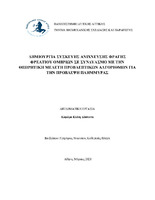| dc.contributor.advisor | Nikolaou , Grigoris | |
| dc.contributor.author | Καμάρα, Ελένη-Δέσποινα | |
| dc.date.accessioned | 2021-03-23T09:04:01Z | |
| dc.date.available | 2021-03-23T09:04:01Z | |
| dc.date.issued | 2021-03-03 | |
| dc.identifier.uri | https://polynoe.lib.uniwa.gr/xmlui/handle/11400/466 | |
| dc.identifier.uri | http://dx.doi.org/10.26265/polynoe-317 | |
| dc.description.abstract | Η διπλωματική αυτή χωρίζεται σε δύο τομείς. Το πρώτο και βασικότερο κομμάτι αναφέρεται στην υλοποίηση μιας συσκευής, η οποία εισέρχεται εντός ενός φρεατίου ομβρίων υδάτων και έχει σαν σκοπό την ανίχνευση της φραγής του. Η συσκευή αποτελείται από ένα μικροελεγκτή Arduino UNO με ένα wi-fi module που, ουσιαστικά, το μετατραπεί σε IoT (Διαδίκτυο των Αντικειμένων) συσκευή και σε συνδυασμό με αισθητήρα επίπλευσης που ανιχνεύει την την φραγή του σωλήνα εντός του φρεατίου, αισθητήρα στάθμης νερού για την μέτρηση της στάθμης του νερού και αισθητήρα υγρασίας που μετρά τα επίπεδα υγρασίας εντός του φρεατίου, μπορεί να καθορίστει η κατάσταση ενός φρεατίου. Όλα τα δεδομένα που συλλέγονται από τους αισθητήρες αποθηκεύονται στο Cloud. Ακόμη, στήθηκε μια ιστοσελίδα, όπου ενημερώνεται με τα δεδομένα των αισθητηρίων.
Το δεύτερο κομμάτι της διπλωματικής αφορά την θεωρητική μελέτη διαφόρων αλγορίθμων μηχανικής μάθησης με σκοπό να επιλεχθεί ο κατάλληλος αλγόριθμος ώστε να επιτευχθεί η πρόβλεψη μιας πλημμύρας. Με τα δεδομένα που παρέχονται από τα αισθητήρια σε συνδυασμό με άλλα δεδομένα όπως τα γεωμορφολογικά στοιχεία μιας περιοχής, τα χιλιοστά και οι ώρες βροχής μπορεί να υλοποιηθεί ένας αλγόριθμος που θα επιστρέφει την πιθανότητα πλημμύρας ανάλογα με την κατάσταση των φρεατίων.
Αυτή η εργασία θα μπορούσε να βοηθήσει δήμους διότι θα ενημερώνονται real-time για την κατάσταση των φρεατίων και θα μπορούν να ενεργήσουν με ταχύτερους ρυθμούς σε περίπτωση ανάγκης. Επίσης, μπορεί να προσφέρει σημαντικές πληροφορίες που θα βοηθήσει στην ανακατασκευή ελαττωματικών φρεατίων. | el |
| dc.format.extent | 105 | el |
| dc.language.iso | el | el |
| dc.publisher | Πανεπιστήμιο Δυτικής Αττικής | el |
| dc.rights | Αναφορά Δημιουργού - Μη Εμπορική Χρήση - Παρόμοια Διανομή 4.0 Διεθνές | * |
| dc.rights | Attribution-NonCommercial-NoDerivatives 4.0 Διεθνές | * |
| dc.rights.uri | http://creativecommons.org/licenses/by-nc-nd/4.0/ | * |
| dc.subject | Arduino UNO | el |
| dc.subject | Πλημμύρες | el |
| dc.subject | HTML | el |
| dc.subject | PHP | el |
| dc.subject | AJAX | el |
| dc.subject | JS | el |
| dc.subject | Arduino | el |
| dc.subject | Διαδίκτυο πραγμάτων | el |
| dc.subject | Internet of things | el |
| dc.subject | IoT | el |
| dc.subject | Μηχανική μάθηση | el |
| dc.subject | MySQL | el |
| dc.title | Δημιουργία συσκευής ανίχνευσης φραγής φρεατίου ομβρίων υδάτων σε συνδυασμό με την θεωρητική μελέτη προβλεπτικών αλγόριθμων για την πρόβλεψη πλημμύρας | el |
| dc.title.alternative | Creation of a 'manhole block' detection device in combination with the theoretical study of predictive algorithms for flood prediction | el |
| dc.type | Διπλωματική εργασία | el |
| dc.contributor.committee | Drosos, Christos | |
| dc.contributor.committee | Βασιλειάδου, Σουλτάνα | |
| dc.contributor.faculty | Σχολή Μηχανικών | el |
| dc.contributor.department | Τμήμα Μηχανικών Βιομηχανικής Σχεδίασης και Παραγωγής | el |
| dc.description.abstracttranslated | This thesis is divided into two parts. The first part refers to the implementation of a device, which enters a rainwater well/manhole and aims to detect its blockage. The device consists of an Arduino UNO microcontroller with a wi-fi module, in order for it to be converted into an IoT (Internet of Things) device and in combination with a float sensor that detects the blockage of the pipe inside the well, a water level sensor to measure its level water and humidity sensor that measures the humidity levels inside the well, we can determine the condition of a rainwater well/manhole. All data collected by the sensors is stored in the Cloud. In addition, a website has been set up, where it is updated with the current data of the sensors.
The second part focuses on the theoretical study of various machine learning algorithms in order to achieve the prediction of a flood. With the data provided by the sensors in combination with other data such as the geomorphological data of an area, the millimeters and hours of rain, an algorithm can be implemented that will return the possibility of flooding depending on the condition of the wells.
This work could help municipalities because they will be informed in real-time about the condition of the wells and will be able to act faster in case of need. It can also provide important information that will help in the reconstruction of defective wells. | el |


